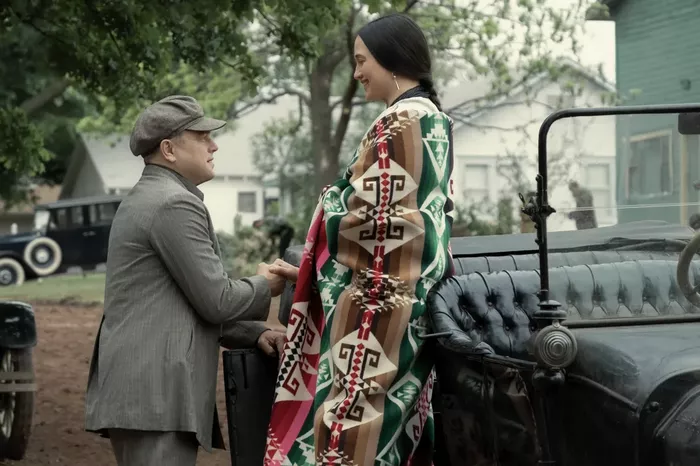Martin Scorsese’s cinematic masterpiece, Killers of the Flower Moon, delves into the harrowing tale of the Osage Nation’s struggle for justice in the face of insidious crimes that rocked their community to its core. As the narrative unfolds, the audience is confronted with the devastating consequences of the Osage murders, theft, and betrayal, underscoring the profound injustices suffered by a people whose very existence was marked by relentless persecution and exploitation. Against this backdrop of turmoil and treachery, the portrayal of the Osage murders trial and its eventual outcome serves as a testament to the enduring resilience and unwavering determination of a community that refused to be silenced or forgotten.
1. The Ruthless Machinations of William King Hale
At the heart of the gripping narrative lies the nefarious plot orchestrated by William King Hale, a man whose insatiable greed and cunning deception precipitated a series of heinous crimes that reverberated throughout the Osage community. Hale’s calculated plan to eliminate Mollie Burkhart’s entire family, driven by a ruthless desire to inherit their valuable headrights, exemplified the depths to which he was willing to descend in pursuit of personal gain. His manipulation of trust and influence within the community enabled him to operate with impunity, concealing his malicious intentions beneath a facade of false benevolence and camaraderie, thereby perpetuating a cycle of violence and betrayal that would leave an indelible mark on the collective consciousness of the Osage Nation.
2. The Collusion of Deception: Ernest Burkhart’s Betrayal
Amidst the turmoil and devastation, the character of Ernest Burkhart emerges as a central figure whose journey embodies the complexities of complicity and moral reckoning. His decision to testify against his own uncle, William King Hale, stemmed from a pivotal moment of realization, wherein the weight of his culpability and the consequences of his actions became too profound to ignore. Ernest’s gradual awakening to the true extent of Hale’s callous disregard for the well-being of the Osage community catalyzed a seismic shift in his conscience, prompting him to confront the depths of his own betrayal and the irreparable damage inflicted upon those whom he was meant to protect. In this poignant portrayal of personal redemption and moral awakening, Ernest’s journey serves as a poignant reminder of the transformative power of accountability and the enduring quest for absolution in the face of unspeakable atrocities.
3. The Osage Nation’s Quest for Justice and Healing
As the Osage murders trial unfolded, the resilience and unwavering determination of the Osage Nation to seek justice for the crimes committed against their community became a beacon of hope amidst the pervasive darkness of betrayal and exploitation. Their steadfast commitment to unearthing the truth and holding the perpetrators accountable exemplified the collective resolve to reclaim their dignity and rebuild their fractured sense of identity and belonging. The trial’s outcome, a testament to the enduring strength and resilience of the human spirit, stood as a defining moment in the history of the Osage Nation, reaffirming their unyielding spirit and unwavering pursuit of justice and healing in the aftermath of unfathomable tragedy.
4. Legacy of Remembrance and Resilience
In the aftermath of the trial, the legacy of the Osage murders resonated far beyond the confines of the courtroom, leaving an indelible mark on the collective consciousness of a nation grappling with the enduring trauma of its turbulent history. The legacy of remembrance and resilience forged through the crucible of suffering and perseverance serves as a poignant reminder of the importance of acknowledging and confronting the darkest chapters of our shared past. Through the lens of Killers of the Flower Moon, the narrative of the Osage murders trial and its profound implications transcend the boundaries of time and space, compelling us to reckon with the echoes of injustice and the enduring quest for truth, reconciliation, and the healing power of collective memory.
Conclusion
Killers of the Flower Moon’s poignant exploration of the Osage murders trial and its transformative impact on the Osage Nation stands as a testament to the enduring resilience and unwavering spirit of a community that refused to be silenced or forgotten. Against the backdrop of treachery and betrayal, the pursuit of justice and healing emerged as a rallying cry for collective remembrance and reconciliation, affirming the indomitable power of the human spirit to transcend the darkest shadows of history and forge a path towards a future rooted in compassion, understanding, and the enduring pursuit of truth and justice. As the legacy of the Osage murders trial continues to resonate through the corridors of time, it serves as a poignant reminder of the imperative to confront our shared history with empathy, humility, and a steadfast commitment to building a more just and equitable world for generations to come.

